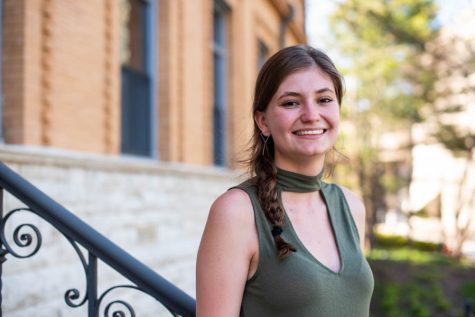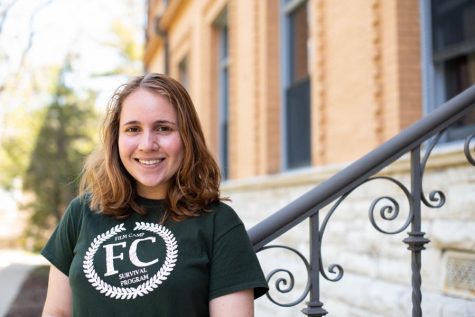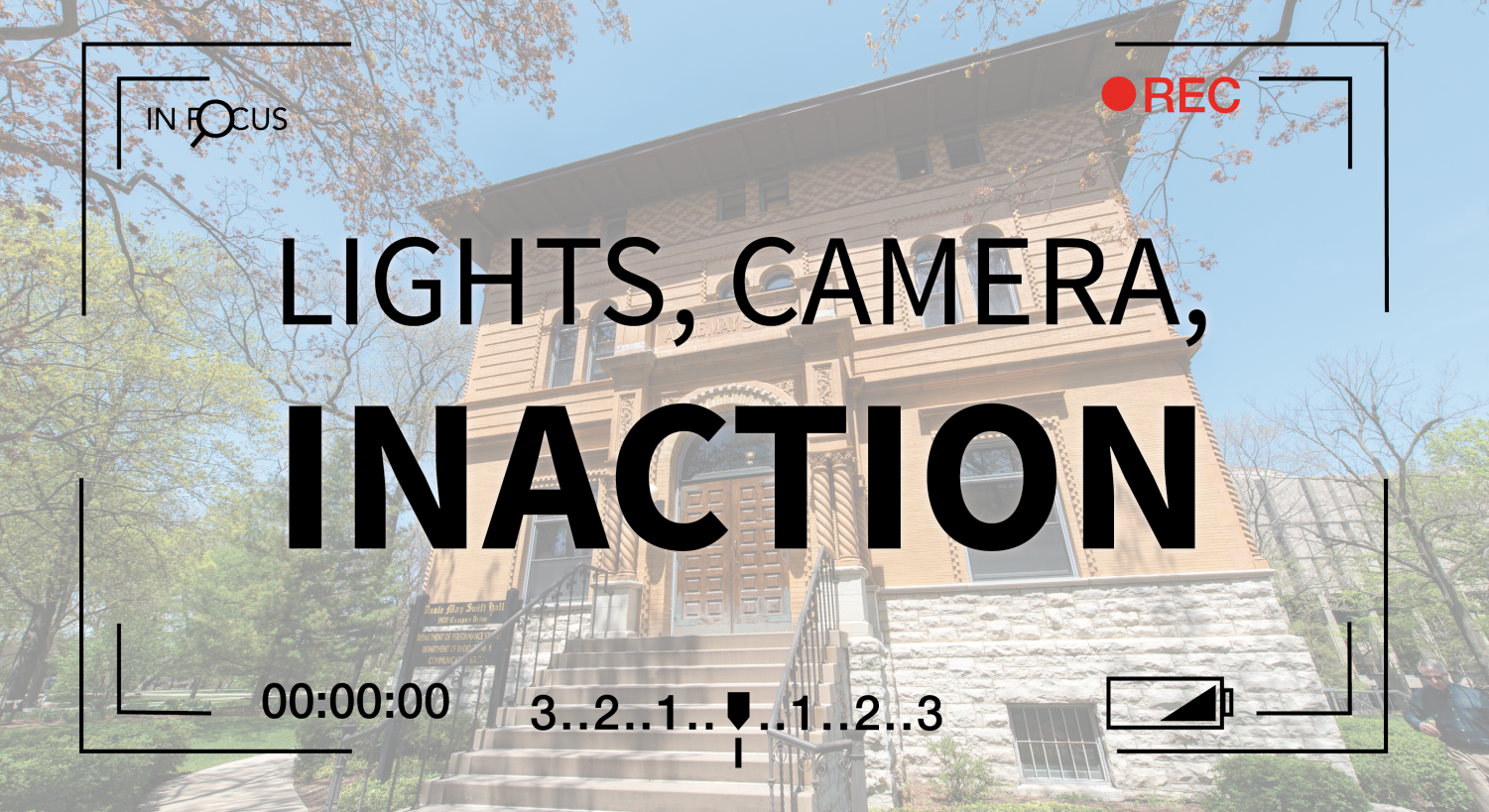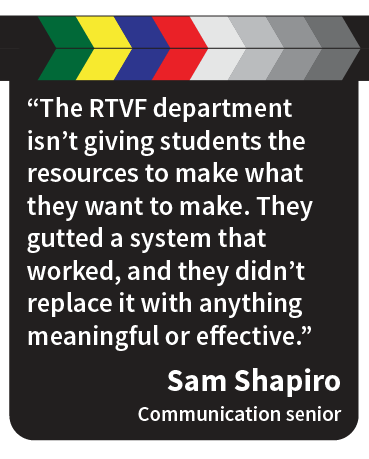In Focus: Following years of limited departmental accountability, RTVF students push for Media Arts Grant reform
May 16, 2018
About two years ago, Northwestern awarded Communication senior Sam Shapiro a $1,000 grant to create a short film. He never finished it. Shapiro believes he didn’t deserve the money in the first place.
These funds were designated through the Media Arts Grant system, which was implemented by the Department of Radio, Television and Film in fall 2015 to allow undergraduates to produce an extracurricular media-related project. The program is intended to encourage students to create anything from a musical album to a video game, but many choose to shoot a short film.
Shapiro did not submit a script when he applied for this grant. Instead, he only wrote a short summary of his idea, not expecting to receive the $1,000 award.
“When I got it, I was like, ‘Wait. I don’t want to do this though.’ And that was fine, which it shouldn’t be,” Shapiro said. “I shouldn’t have gotten it, realistically. That’s how you know the system is flawed.”

Communication senior Sam Shapiro
Shapiro received the grant — which can only be accessed through a reimbursement system — during Fall Quarter 2016. He initially thought he’d be pressured by the department to complete his film, but he wasn’t. There were no repercussions for his decision not to shoot the film.
Between three classes and an internship, Shapiro said he recognized he didn’t have time to fully commit to the film, and ended up leaving his funds untouched and his project unfinished. However, he said guidance from the department could’ve changed the outcome.
“(Media Arts Grants) give students money, but that’s it,” Shapiro said. “Students need more than that. … They need notes. They need a team. They need assistance in making their vision realistic.”
Like Shapiro, other undergraduates have raised concerns that the department’s MAG funding system leaves them under-supported and unmotivated to finish their projects, even compelling some to abandon them altogether. Northwestern allocates thousands of dollars annually to fund extracurricular projects through these grants, but some students say the funding process has led to a fall in accountability and representation.
In an effort to change the system, more than 160 students signed a proposal recommending that the department require scripts for grant applications, take diversity into consideration when assigning grants and give feedback to recipients. The proposal also encourages the department to move away from the reimbursement system to make funds more accessible.
Communication Prof. Eric Patrick — who has overseen the MAG system for the past year — said he is aware of some of the shortcomings within the MAG system. However, he doesn’t think it is an “absolute catastrophe.”
“There are things in the proposal that I’m sure … we can do very easily,” he said. “There are things in the proposal that are completely untenable and we won’t do at all.”
As the department considers the proposal, some students remain unsatisfied as another academic year ends with no clear solution in sight.
“We’ve had this system in place for three years, and these issues haven’t been resolved,” said Communication junior Megan Ballew, co-president of Studio 22 Productions. “It’s not fair to (incoming) students … to have to face these same issues with the MAG system that we’ve been facing.”
Proposing a new system
Before the RTVF department implemented the MAG system in 2015, groups such as Studio 22, Multicultural Filmmakers Collective and Northwestern University Women Filmmakers Alliance selected and funded several projects each year.
RTVF department chair David Tolchinsky told The Daily in May 2016 that the switch to this system was intended to “end student-to-student direct funding.” In the old system, the student executive boards would dole out grants worth thousands of dollars to their peers.
Tolchinsky did not respond to multiple requests for comment for this story.
Under the new system, rather than having student groups select projects to fund, RTVF undergraduates apply for a grant through the department. Their ideas are judged by an anonymous panel composed of undergraduates, graduate students and faculty members, according to the MAG application. The panelists score the applications based on several factors, including feasibility, quality of prior work, and clarity and originality of the project.
The grants range from $500 to $1,000, and those who receive one may apply for an additional $500 to pay for post-production costs. MAG recipients can also pitch the idea to one of the student groups for a partnership that would include guidance and resources from the executive board and a “plus-up” of no more than $500.

Communication junior Megan Ballew
Freshmen and eligible transfer students can apply for a $500 New Student Grant, which is given once per year. Students cannot receive a MAG and a New Student Grant concurrently.
The department receives anywhere from five to 40 MAG applications each quarter, Patrick said. The number of MAGs given out depends on the department’s budget and the types of projects pitched, as some require fewer resources, he added.
However, in the proposal sent to RTVF administrators in March, students said this system “contains critical, detrimental flaws” that result in a large number of unfinished projects and a lack of diverse representation, in both the stories told and the storytellers themselves.
Ballew, one of the proposal’s co-authors, said changing the system right now will make the funding process easier down the road for everyone.
“(The RTVF administrators) try to make it as simple as possible for themselves,” said Ballew, who received a MAG in spring 2017. “The way it’s set up, it’s not benefiting the student body.”
Patrick said the MAG system was “very ambitious in the way it was constructed.” He said modifying it will require some negotiations between students and administrators.
“There’s some dissatisfaction (especially among) people associated with student groups, because it was a major paradigm shift in funding,” he said. “A lot of this seems to come directly out of that.”
Dasha Gorin, treasurer of the Undergraduate Radio/Television/Film Student Association, said the goal of the proposal was to show how many individuals were concerned about these issues. Out of the 76 students who have received a Media Arts Grant since the program was implemented, 31 signed the proposal. Gorin, a Communication senior, said the number of grant recipients who also called for reform highlights the flawed system.
“We sort of got the feeling that the administration didn’t feel that the majority of undergraduates wanted this, but rather just a select amount,” said Gorin, a co-author of the proposal. “The need for change is felt not just by undergraduates generally, but also the specific people who are getting the limited department support that MAGs provide.”
Withholding funds
Media Arts Grants are essentially reimbursements, forcing recipients to initially cover production costs and keep a close eye on expenses.
Communication senior Maggie Astle said she knew she would be fronting most of the money for her film.
“I’m lucky that I am able to do that,” she said. “A lot of people can’t afford to do that. That’s a barrier that they have to making a project that the school is supposed to be funding.”
Students are expected to use tax-exempt forms when making purchases, as the department doesn’t reimburse sales tax, according to the financial awards packet sent to MAG recipients. However, Astle said the process to use the forms was complicated.

Communication senior Dasha Gorin
As a former URSA co-chair, Gorin said she saw underclassmen struggling with this funding process.
“A lot of them were under the impression they would just get the money up front and that there wasn’t this complicated reimbursement process,” Gorin said. “They had no knowledge of how to file the paperwork.”
An additional rule mandates that recipients can only access the last 10 percent of their grant funds after submitting a final project, Patrick said.
He said this rule was added in reaction to students “bemoaning the lack of accountability.”
However, the authors of the proposal said this can present an unnecessary barrier for low-income students and does not encourage recipients to complete their projects. Instead, they suggest that the department remove this requirement.
“Presumably, (a MAG recipient) presented an accurate budget, so they need all of that money in order to complete the project,” Gorin said.
In addition to the complicated process, Gorin said recipients are required to spend their MAG by the end of the academic year, which creates an issue if a student films in the spring. She said these students are in a “huge pinch” to complete editing before the summer so they can access the remaining 10 percent of the funds.
These problems, Gorin said, leave MAG recipients with little guidance surrounding how to use their funds.
“It’s not even just the money that you get, because you still have to learn this complicated, bureaucratic system for accessing the money,” she said. “Lack of support is really the biggest issue.”
Diversifying stories
Immediately after receiving a MAG in fall 2017, Astle looked at the names of the eight other recipients. She was the only woman.
Noticing a list of primarily men wasn’t new to Astle. Earlier that quarter, she kept witnessing the same thing: male-dominated crews on film sets.
When building a crew for her MAG project, Astle recalled how her “most comfortable” film experience happened on a majority-female crew, where she didn’t feel judged or self-conscious. However, she realized this was uncommon, as there was generally a lack of female representation among crew members for sets. After pointing out that many crews were composed of mostly men, she said her peers told her this happened because “only men came to petition.”
Astle said she heard the same response — that women weren’t applying — from RTVF administrators.
“They’re just saying, ‘There’s nothing we can do about it,’’’ Astle said. “When in fact, they can do everything about it because they’re the ones that created this system.”
Before the MAG system was implemented, students could apply for a $1,000 grant from NUWFA, which supports projects by those who identify as women, transgender and/or gender-nonconforming. But when the MAG system took over, NUWFA could no longer pick which projects it would fund. Instead, students now receive MAG funding first and then can apply for additional NUWFA funding.
The new MAG system, Astle said, ignores NUWFA’s purpose as an organization and has added to the lack of diversity among MAG recipients.
Astle said in order for the group to provide extra funding, the administration needs to award MAGs to multiple students who would be eligible for the NUWFA grant. Otherwise, she said, NUWFA will be left with few choices for its grant recipients.
“(Administrators are) limiting our options so much,” Astle said. “They’re not making an effort to ensure that there’s any diversity among the recipients.”
Patrick said administrators try to include a diverse range of projects in each MAG cycle. He noted, however, that Astle’s round of MAG recipients was an “outlier” because very few women applied.
“Certainly, we need more diversity and we want more diversity,” Patrick said, “but I think that’s going to have to start from sort of a germination point of actually getting more people to apply for MAGs, especially women.”
Patrick said he reviewed the applicant pool from last spring and noted a more balanced representation of men and women. The lack of diversity is a concern, he said, but the steps to ensure diverse representation among recipients remain “ambiguous” as the administration tries to decide how to continue with the MAG system in the future.
Similarly, Multicultural Filmmakers Collective, which supports projects by people from underrepresented backgrounds, has also seen fewer applicants for its grant under the MAG system, said Ivy Gao, former co-president of the group. Instead of accepting applications from any student with a multicultural background for its grant, she said the group is limited to a pool of MAG recipients.
“If there aren’t people of color that get MAGs, then there aren’t people of color applying to the MultiCulti grant,” the Communication senior said. “It’s very frustrating when there’s only two or three people who are the only ones eligible to apply, when there are so many other storymakers of color that I wish we could give opportunities to.”
In an attempt to increase the number of female applicants and applicants of color, Studio 22, Multicultural Filmmakers Collective and NUWFA hosted a “MAGs for Diversity” information session in April to answer questions before they applied for this spring’s MAG cycle.
“We are doing our best, but this isn’t necessarily the students’ responsibility,” Ballew said. “(The administrators are) filmmakers, too. They see these issues in the industry.”
Poor accountability
Shapiro, the Communication senior who did not complete his MAG project, said he did not receive guidance from the RTVF department on how to proceed with his idea.
“I got one email from them saying ‘Hey, you got the money. Congratulations,’” Shapiro said. “That’s it. There was no follow up. There was no information about how to get the money. I had no idea why mine was selected. I got no feedback. I didn’t get any direction.”
Like Shapiro, Communication senior Orli Spierer didn’t submit a script when she applied for a MAG in spring 2016. Instead, she included a summary of a story from her creative writing class.
Spierer said the department notified her that she’d received the grant around the last week of school as she prepared for finals and a summer studying abroad in Israel. But it was too late to write a script or coordinate a crew.
“If I heard earlier that I had it and had more time to get ready before I left for the summer, or if I had a screenplay when I submitted (the application), I would have felt more ready,” Spierer said.
And because no one ever reached out to her after she received her MAG, Spierer said she wasn’t held accountable for creating her film. Spierer and Shapiro never accessed their funds, so the money remained with the RTVF department.

Communication senior Orli Spierer
“I really didn’t want to do it anymore,” Spierer said. “It’s more stress than it’s worth.”
Before the transition to the MAG system, Shapiro said he was actively involved on student film sets because students were “giving their all” to create the best product possible.
However, he said his disorienting experience with the MAG system was part of the reason he later distanced himself from RTVF productions.
“The RTVF department isn’t giving students the resources to make what they want to make,” Shapiro said. “They gutted a system that worked, and they didn’t replace it with anything meaningful or effective.”
But Patrick said he doesn’t think there have been as many unfinished MAGs as “some people have been led to believe.” He said MAGs are not part of the RTVF curriculum, so the department does not force students to finish their work.
“At the end of the day, these are extracurricular projects,” he said. “I am not going to be a policeman for people’s completing an extracurricular project. We already have those kinds of things in place for our curriculum, which is our main thing that we do here.”
Quality over quantity
Since the implementation, there have been 76 recipients of the Media Arts Grants. This has led to an increase in extracurricular projects compared to previous years, in which student-to-student funding generally supported about 13 films annually.
“That’s objectively a good thing,” said Gao, the former president of Multicultural Filmmakers Collective. “But the problem is that the films coming out aren’t completed projects.”
Ballew, the Studio 22 co-president, said the greater demand for crew and equipment has created a shortage of both. Filmmakers tend to “go big or go home” when planning their production, she said.
“Because of the culture here, everyone wants a huge crew, so you’re just flooding the market and everything is depleted,” she said. “I don’t necessarily want to ask the department to offer less grants because it gives less people opportunities, but something needs to change.”
Grant recipients are given the first five weeks of the quarter to access the equipment needed to shoot their films. Only a small portion of RTVF students — those in approved groups or certain production classes — regularly have access to the Cage, which houses film equipment.
Additionally, recipients are only allowed to film their projects for two weekends in the first half of the quarter. In the proposal, students called this timeline “unsustainable.” Instead, they suggested that the policy be modified to allow recipients the first seven weeks of the quarter to shoot their films.
Gao said the smaller freshman class size has also strained productions, as there aren’t enough crew members to work on the numerous sets.
In an October email to The Daily, Communication Dean Barbara O’Keefe said 36 members of the Class of 2021 enrolled in Northwestern as RTVF majors, yielding about 53 percent of accepted students. O’Keefe said this matriculation rate was within the school’s normal range of 50 to 60 percent.
In 2016, 56 members of the Class of 2020 were invited to First-Year Filmmakers, a program that all incoming RTVF majors can attend, according to an invitee list obtained by The Daily. Exact enrollment numbers aren’t available for other RTVF years.
To help more recipients finish their projects, Gao said the department needs to find a balance between “quantity and quality” of the films. She added that greater faculty investment in their advisee’s work would be beneficial to the production process.
Gao said she applied for other funding to create her project, but a MAG was the first grant she received. While issues exist with the current system, she said she wouldn’t have been able to complete her film if it weren’t for the MAG.
“I was able to make my project into fruition without having to put my own money into it,” Gao said. “$1,000 isn’t easy for me. It’s not something I can just spend. That’s the biggest benefit of the MAG.”
The future of MAGs
More than a month after submitting the proposal to the department, its authors — including Ballew and Gorin — met with Patrick on May 6 to discuss further changes to the system. They updated it with compromises and presented it to Tolchinsky, the department chair, at a meeting three days later.
The new system would consist of two separate processes through which students could apply for funding, Gorin said. One process — for larger, more traditional projects — would allow them to pitch to student groups, and if they were to receive a grant and partnership offer, the department would approve each project. The other process, intended for smaller or more experimental projects, would function similarly to the current MAG system, in which students would apply to work independently.
“We realized that the department was open to more radical change than we expected,” Gorin said. “This new suggestion, we think, is actually an improvement upon the original proposal that was presented.”
Gorin said ideally, 12 grants would be given out by student groups, with six coming from Studio 22 and the rest split among NUWFA, URSA and Multicultural Filmmakers Collective.
While it is unclear whether the new system will be approved by other School of Communication administrators and when it would potentially go into effect, Ballew said Tolchinsky seemed enthusiastic about their ideas.
Still, Ballew said she is only “cautiously excited” about the RTVF department’s consideration of the proposal as negotiations with other School of Communication administrators continue.
“These changes benefit us. They benefit the department,” Ballew said. “There has to be formal communication. We have to work on this together. … Otherwise, it’s not going to work.”
Email: [email protected]
Twitter: @alliejennaphoto





